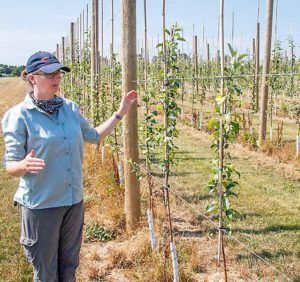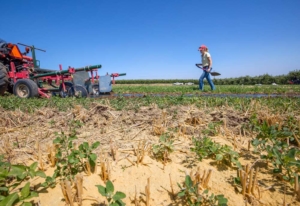—by Matt Milkovich

Managing apple replant disease in Nova Scotia, Canada, used to be simple: Growers would apply the preplant fumigant Telone (1,3-dichloropropene) before planting new trees, and that pretty much took care of the problem.
But ever since Telone’s manufacturer withdrew the fumigant’s Canadian registration, in response to stricter regulations about a decade ago, the Nova Scotia apple industry has been searching for an effective replacement, said Keith Fuller, a research biologist and soil scientist with Agriculture and Agri-Food Canada. Fuller discussed apple replant disease complex and the search for a Telone replacement in July 2023, during an International Fruit Tree Association tour of Nova Scotia’s Annapolis Valley.
Apple replant disease complex affects orchards around the globe, but the participating pathogens and nematodes vary by region and site. In the Annapolis Valley, the “dominant players” are Pythium oomycete species and the P. penetrans plant-parasitic nematode, Fuller said.
After the loss of Telone, new trees grew slowly and unevenly on old orchard land in the Annapolis Valley, showing typical symptoms of apple replant disease. Most Nova Scotia orchards are rain-fed, and though the valley generally receives a fair amount of rainfall, a combination of drought stress and apple replant disease in dry years can permanently stunt the growth of young trees, or even kill them. Without adequate growth in their first couple of years, trees never achieve their maximum crop potential, he said.
Fuller has spent years trialing alternatives in the valley’s commercial orchards, but nothing has worked as well as Telone. Pic Plus (chloropicrin), another preplant fumigant, is only marginally effective. Compost boosts soil biodiversity but doesn’t solve the nematode problem. Anaerobic soil disinfestation with liquid dairy manure works better in theory than in practice. He’s testing different rootstocks for their susceptibility to replant disease.
So, what’s a Nova Scotia grower to do? How can they pull out old blocks and plant new ones without losing crop potential to replant disease?
Fuller said the “worst-case scenario” is replanting the very next season. That’s when replant disease pressure is at its most severe. He recommended taking land out of apple production for a couple of years and planting cover crops to increase soil biodiversity and lower the disease inoculum load.
Fuller said the incidence of replant disease might be less severe in future orchards with higher planting densities, as herbicide strips become narrower and the vegetated laneways between tree rows wider. Disease incidence on roots underneath herbicide strips is higher than on roots underneath vegetated laneways. The laneways, or row middles, contain a greater diversity of grasses, broadleaf weeds, clovers and other plants that boost soil health and help protect against replant disease, he said.

Nova Scotia growers are using multiple methods to manage apple replant disease. Lisa Jenereaux has settled on a combination of cover crops, frequent irrigation applications and vigorous rootstocks. Her new trees tend to grow well and fill space quickly, though they’re still not quite as uniform as they were in the days of Telone, she said.
Jenereaux plants a cover crop of pearl millet the year before putting in a new block of trees. Most of her new Honeycrisp trees are planted on the more vigorous Geneva 935 rootstock.
Jenereaux’s family orchard is one of the few in Nova Scotia that irrigates its fruit trees. The location’s light soils tend to dry out quickly, which can damage trees. Shorter, more frequent irrigation applications give the trees the moisture they need, she said.
Before replanting, grower Waldo Walsh deep-rips his soil to get the old roots out of the ground and break up any obstructions. He incorporates well-rotted manure from his small herd of beef cattle. After the trees are planted, he often adds compost underneath them.
Walsh said he’s tightening tree spacings in new plantings, so there’s less horizontal space to fill and trees reach the top of the support system sooner. He’s also using more vigorous rootstocks. •








Leave A Comment